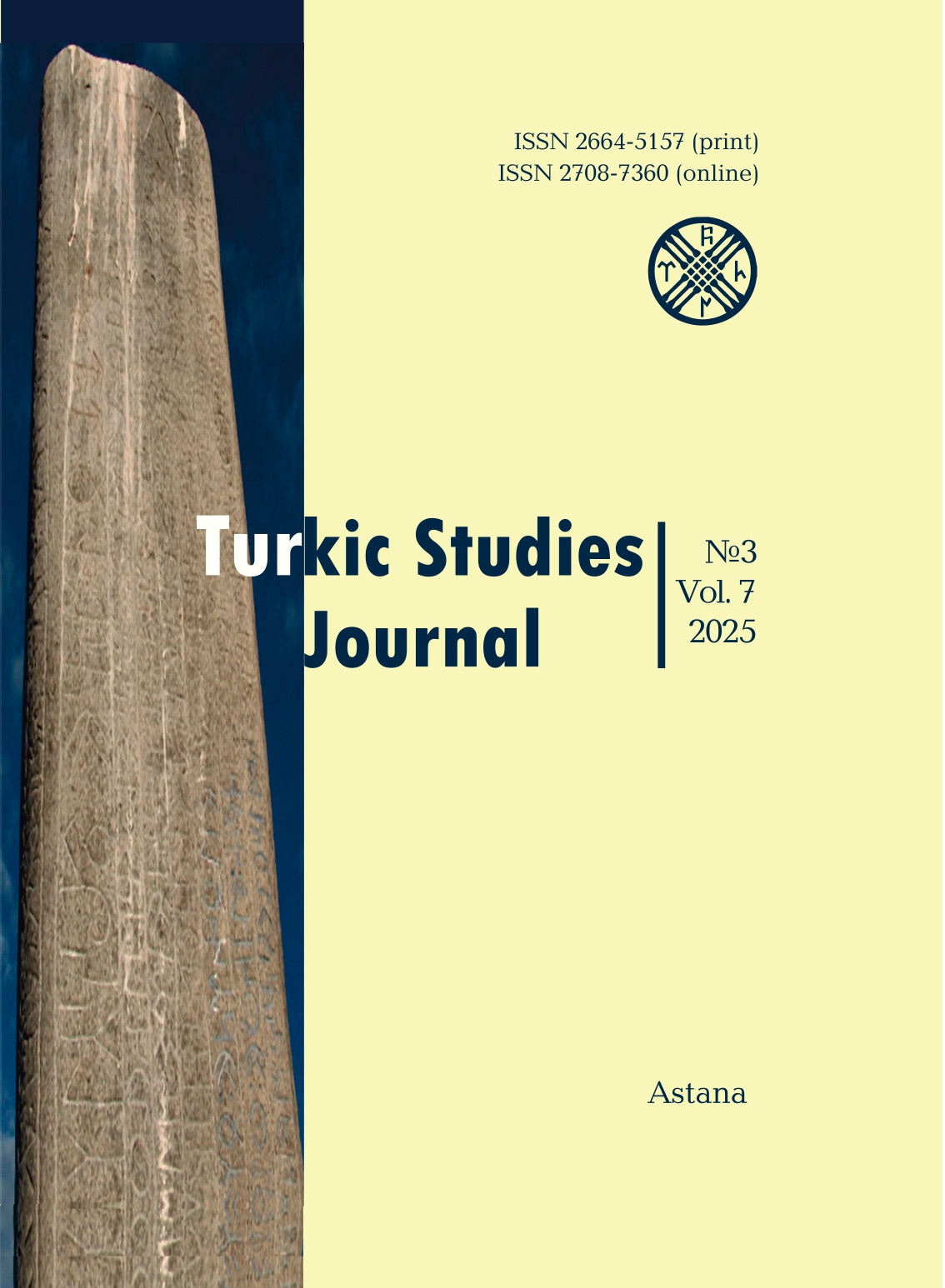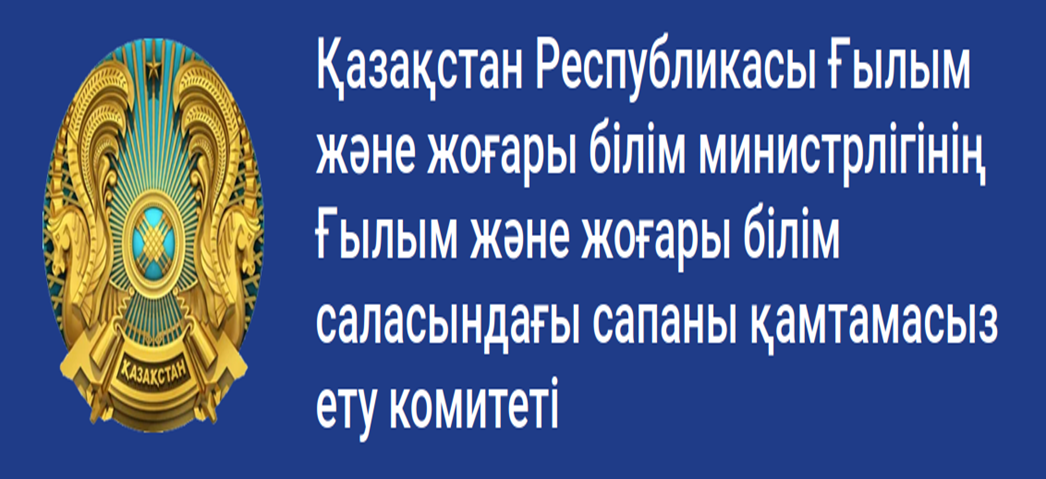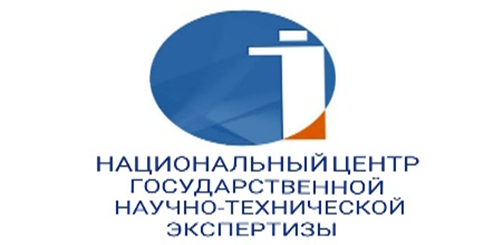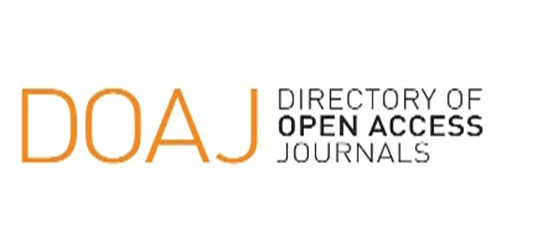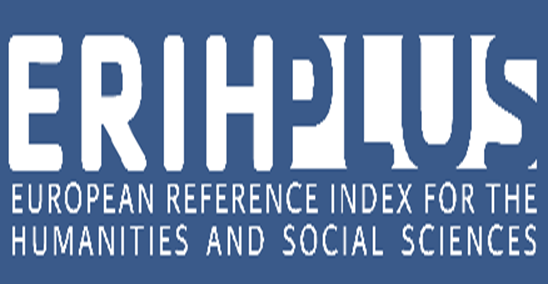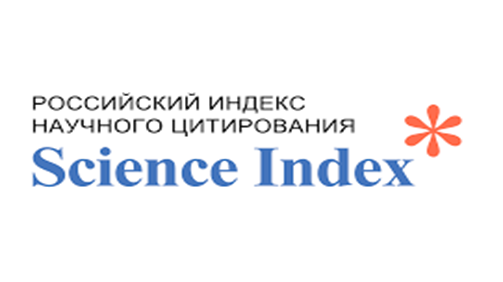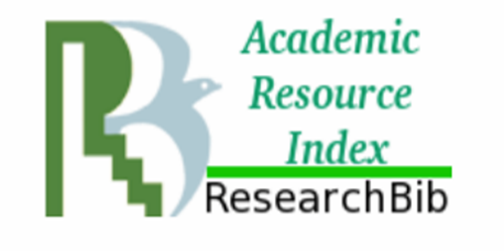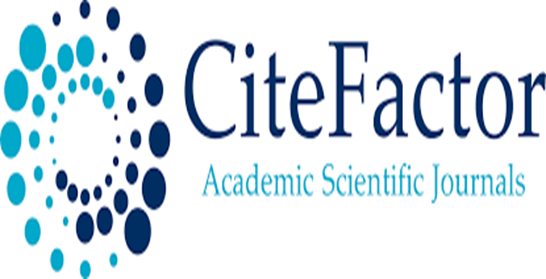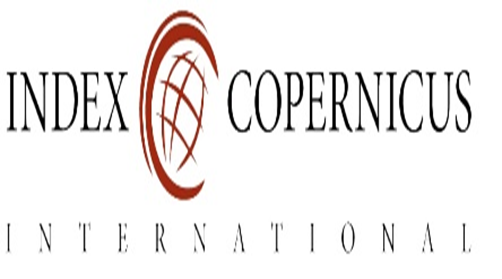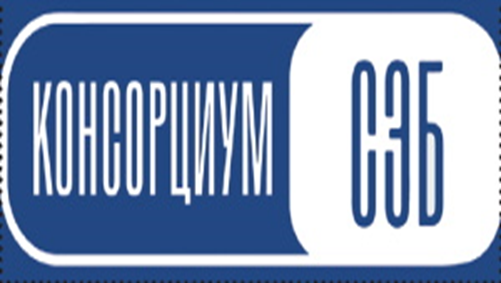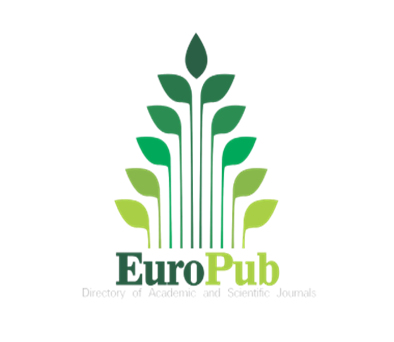Topicalization strategies in the language of Kazakhs in China
Views: 156 / PDF downloads: 54
DOI:
https://doi.org/10.32523/2664-5157-2025-3-147-165Keywords:
Information structure, theme-comment, topicalization, topicalization strategies, sentence-level topicalization, topicalization markers, Orkhon-Old Turkic, Old Uyghur, comparative grammar, Kazakh language in ChinaAbstract
This paper focuses on the unstudied phenomenon of topicalization – or the theme-rheme structure (with “rheme” is understood as “comment”) – in Turkic languages. Topicalization, used in many languages including Turkic, is examined here in the sentence structure of Kazakh as spoken by Kazakhs in China. It is a linguistic phenomenon that highlights specific sentence components to structure information and guide the listener’s or reader’s attention. The research identifies topicalization markers in Kazakh as including grammatical markers (changes in word order, special particles), prosodic markers (intonation, pauses), and syntactic markers (left dislocation, post-predicate topic). The author demonstrates the significance of topicalization markers in the structure of Turkic sentences by analyzing them in both historical Old Turkic languages (Orkhon runic and Old Uyghur) and in modern Turkic languages (Turkish and Uyghur). It is noted that, in the context of living in a foreign-language environment, the Kazakh language in China has been influenced by Chinese, Uyghur, and other languages. Particular attention is therefore devoted to a comparative analysis of topicalization markers in the Kazakh spoken in China with those in Uyghur, Chinese, and Standard Kazakh. The article thoroughly analyzes the morphosyntactic means of expressing topics, the role of prosodic markers in determining topic boundaries, and the manifestation of topicalization through grammatical markers such as ‘γoy’, ‘wözị’,‘bolsa’, and ‘degen’. It also examines themecomment structures and describes the pragmatic functions of topic markers in discourse The findings show minor differences between the Kazakh spoken in China and in Kazakhstan, mainly in syntax and prosody. In Kazakh, topic markers are conveyed through intonation and pauses – a typological feature shared by Turkic languages in general and Kazakh in particular. Post-predicate topicalisation is not systematic. Although multiple topics can be marked in a single sentence, this is not a strict grammatical rule. The study revealed that, as a result of prolonged language contact between Kazakh in China and other languages, some contact influences have developed, but its basic grammatical system remains close to standard Kazakh. This study sheds light on the peculiarities of Kazakh in China and contributes to the study of the information structure of Turkic languages.
Downloads
Reference
Әмір Р., 2002. Екінші дәрежедегі коммуникативтік талаптардың құрмалас сөйлемдер жүйесіндегі көрінуі // Жұбанов тағылымы: Респ-қ ғылыми-теориялық конференция материалдары. Ақтөбе. Б. 11-15.
Әмір Р.С., 2014. Қазіргі қазақ тілі құрмалас сөйлем жүйесі. Алматы: «Қазақ универcитеті» баспасы. 110 б.
Байтұрсынов А., 1992. Тіл тағылымы. Алматы: «Ана тілі» баспасы. 448 б.
Abish A., 2021. Kazakh and Karakalpak. [Қазақ және қарақалпақ тілдері]. In: Johanson & Csató (eds.). P. 337-353.
Chafe W.L., 1976. Givenness, contrastiveness, definiteness, subjects, topics, and point of view. In Charles N. Li (ed.), Subject and topic. New-York: Academic Press. P. 25-55.
Dai Q., 2001. Jǐngpǒ yǔ de huàtí. Language Studies 1. P. 100-105.
Givón T., 1983. Topic continuity in discourse: an introduction. In: Givón, T (ed). Topic continuity in discourse: A quantitative cross-language study. Amsterdam: John Benjamins. P. 3-41.
Halliday M.A.K., 1967. Intonation and grammar in British English. Muton: The Hague.
Hu S., 2004. Liángshān yí yǔ de huàtí jiégòu – jiān lùn huàtí yǔ yǔxù de guānxì. 3. P. 9-15.
Huang Ch., 2008. Qiāng yǔ de huàtí biāojì. 7/6. P. 599-614.
Johanson L. & Csató É.Á. (eds.), 2022. The Turkic languages. Second Edition. (Routledge Family Series.). London and New-York: Routledge. 560 р.
Kadir T. & Slam U., 2015. Wéiwú'ěr yǔ huàtí de yùnlǜ biǎoxiàn. Journal of Xinjiang University 43/5. P. 126-132.
Krifka M. & Musan R., 2012. Information structure: Theoretical, typological and experimental perspectives. Berlin: Deutsche National bibliothek. P. 1-44.
Lambrecht K., 1994. Information structure and sentence form: Topic, focus and the mental representations of discourse referents. Cambridge: Cambridge University Press. 376 p.
Lapolla R.J., 1988. Subject and referent tracking: Arguments for a discourse-based grammar of Chinese. In Emonds, J. & Mistry, P. J. & Samiian, V. & Thornburg, L. (eds.) Proceedings of the West Coast conference on linguistics. Department of Linguistics, California State University, Fresno. P. 60-173.
Lapolla R.J. & Poa D., 2005. Jiāodiǎn jiégòu hé yǔyì de yánjiū. In: Liejiong, X. & Pan, H.(eds.) Jiāodiǎn jiégòu de lèixíng jí qí duì hànyǔ cíxù de yǐngxiǎng. Beijin: Press of Beijin University of Foreign Languages. P. 57-78.
Li B. & Pan H. & Xu L., 2003a. Duì jiāodiǎn mǐngǎn de jiégòu jí jiāodiǎn de yǔyì jiěshì (shàng). 1. P. 1-11, 93.
Li B. & Pan H. & Xu L., 2003b. Duì jiāodiǎn mǐngǎn de jiégòu jí jiāodiǎn de yǔyì jiěshì (xià). 2. P. 108-119.
Li Z., 2007. Hāní yǔ de huàt. 5. P. 74-79.
Lu J., 2014. Shì shuō yǔyán xìnxī jiégòu lǐlùn. Academic Exchange 6. P. 5-13.
Lu J., 2017. Zhòngshì yǔyán xìnxī jiégòu yánjiū kāitùo yǔyán yánjiū de xīn shìyě. 4. P. 1-15.
Lu J., 2018. Zài tán yǔyán xìnxī jiégòu lǐlùn. 2. P. 163-172.
Tömür H., 2003. Modern Uyghur grammar. Morphology. Istanbul: Yildiz Press. 599 p.
Tömür X., 2011. Hazirḳi zaman uyγur tili grammatikisi [A Grammar of Modern Uyghur Morphology]. Morfologiyä. Beijing: The Ethnic Publishing House. 471 p.
Van Valin R.D. & Lapolla R.J., 1997. Syntax. Structure, meaning and function. Cambridge: Cambridge University Press. 713 p. DOI: https://doi.org/10.1017/CBO9781139166799
Wang B. & Kadir T. & Yi X., 2013. Wéiwú'ěr yǔ jiāodiǎn de yùnlǜ shíxiàn jí gǎnzhī, 38/1. P. 92-98.
Wei W., 2012. Qiǎn xī hāsàkè yǔ jùzi jiāodiǎn chéngfèn de jù zhòngyīn biǎoxiàn. 4. P. 30-33.
Xu L. & Liu D., 2003. Huàtí yǔ jiāodiǎn xīn lùn. Shanghai: Shanghai Education Press.
Xu L. & Liu D., 2007. Huàtí de jiégòu yǔ gōngnéng. Shanhai: Shanhai Education Press.
Yakup A. & Zhang D. (eds.), 2013. Functional typological approach to modality in the Altaic languages, Analytic comparative linguistic data: 400 sentences. Beijin: Press of Midzu China University.
Yakup A., 2016. Focus in Turkish and Uyghur: A preliminary report on an ongoing contrastive investigation. Turkic Languages 20. P. 113-131.
Yu Ch. 2011 Zàng miǎn yǔ de huàtí biāojì: jiān yǔ hànyǔ bǐjiào. Journal of Midzu China University Sciences of Philosophy and Social Sciences 38/1. P. 77-81.
Zhang D., 2004. Xiàndài hāsàkè yǔ shǐyòng yǔfǎ. Beijin: Press of Midzu China University. P. 712-713
Zhang D., 2015. Shítǐ yǔfǎ lǐlùn – hāsàkè miáoxiě yǔfǎ xué fāngfǎlùn. Beijin: Press of Midzu China University.
Zhang D., 2018. 2. Xiàndài hāsàkè yǔ shǐyòng yǔfǎ (Xiūdìng bǎn). Beijin: Press of Midzu China University.
Zhang B. & Fang M., 1996. Hànyǔ gōngnéng yǔfǎ yánjiū. Press of Tziansi Education.
Zhao Y. & Li Y., 2005. Lùn bái yǔ de huàtí jiégòu yǔ jīběn yǔxù lèixíng. 6. P. 10-22.
Zhou Sh. & Ning Y., 2012. Xiàndài wéiwú'ěr yǔ de huàtí jiégòu. Journal of Beijin Pedagogical University. P. 52-58.
Zimmermann M. & Féry C., 2010. Information structure: Theoretical, typological, and experimental perspectives. Cambridge: Cambridge University Press. 412 p. DOI: https://doi.org/10.1093/acprof:oso/9780199570959.001.0001
Reference
Amir R., 2002. Ekınşı därejedegı kommunikativtık talaptardyŋ qūrmalas söilemder jüiesın-degı körınuı [Manifestation of communicative requirements of the second degree in the system of compound sentences]. Jūbanov tağylymy: Resp-q ğylymi-teoriıalyq konferentsiıa materialdary [Zhubanov's lessons: materials of the scientific and theoretical conference]. Aktobe. Р. 11-15. [in Kazakh].
Amır R., 2014. Qazırgı qazaq tılı qūrmalas söilem jüiesı [Modern Kazakh language complex sentence system]. Almaty: “Qazaq universitetı” baspasy. 110 p. [in Kazakh].
Baitursynov A., 1992. Tıl tağylymy [Language lessons]. Almaty: “Ana tılı” baspasy. 448 p. [in Kazakh].
Abish A., 2021. Kazakh and Karakalpak. In: Johanson & Csató (eds.). P. 337-353. DOI: https://doi.org/10.4324/9781003243809-22
Chafe W.L., 1976. Givenness, contrastiveness, definiteness, subjects, topics, and point of view. In Charles N. Li (ed.), Subject and topic. New-York: Academic Press. P. 25-55.
Dai Q., 2001. Jǐngpǒ yǔ de huàtí. Language Studies 1. P. 100-105. [in China].
Givón T., 1983. Topic continuity in discourse: an introduction. In: Givón, T (ed). Topic continuity in discourse: A quantitative cross-language study. Amsterdam: John Benjamins. P. 3-41. DOI: https://doi.org/10.1075/tsl.3
Halliday M.A.K., 1967. Intonation and grammar in British English. Muton: The Hague.Hu S., 2004. Liángshān yí yǔ de huàtí jiégòu – jiān lùn huàtí yǔ yǔxù de guānxì. 3. P. 9-15. [in China]. DOI: https://doi.org/10.1515/9783111357447
Huang Ch., 2008. Qiāng yǔ de huàtí biāojì. 7/6. P. 599-614. [in China].
Johanson L. & Csató É.Á. (eds.), 2022. The Turkic languages. Second Edition. (Routledge Family Series.). London and New-York: Routledge. 560 р. DOI: https://doi.org/10.4324/9781003243809
Kadir T. & Slam U., 2015. Wéiwú'ěr yǔ huàtí de yùnlǜ biǎoxiàn. Journal of Xinjiang University 43/5. P. 126-132. [in China].
Krifka M. & Musan R., 2012. Information structure: Theoretical, typological and experimental perspectives. Berlin: Deutsche National bibliothek. P. 1-44. DOI: https://doi.org/10.1515/9783110261608.1
Lambrecht K., 1994. Information structure and sentence form: Topic, focus and the mental representations of discourse referents. Cambridge: Cambridge University Press. 376 p. DOI: https://doi.org/10.1017/CBO9780511620607
Lapolla R.J., 1988. Subject and referent tracking: Arguments for a discourse-based grammar of Chinese. In Emonds, J. & Mistry, P. J. & Samiian, V. & Thornburg, L. (eds.) Proceedings of the West Coast conference on linguistics. Department of Linguistics, California State University, Fresno. P. 60-173.
Lapolla R.J. & Poa D., 2005. Jiāodiǎn jiégòu hé yǔyì de yánjiū. In: Liejiong, X. & Pan, H.(eds.) Jiāodiǎn jiégòu de lèixíng jí qí duì hànyǔ cíxù de yǐngxiǎng. Beijin: Press of Beijin University of Foreign Languages. P. 57-78. [in China].
Li B. & Pan H. & Xu L., 2003a. Duì jiāodiǎn mǐngǎn de jiégòu jí jiāodiǎn de yǔyì jiěshì (shàng). 1. P. 1-11, 93. [in China].
Li B. & Pan H. & Xu L., 2003b. Duì jiāodiǎn mǐngǎn de jiégòu jí jiāodiǎn de yǔyì jiěshì (xià). 2. P. 108-119. [in China].
Li Z., 2007. Hāní yǔ de huàt. 5. P. 74-79. [in China].
Lu J., 2014. Shì shuō yǔyán xìnxī jiégòu lǐlùn. Academic Exchange 6. P. 5-13. [in China].
Lu J., 2017. Zhòngshì yǔyán xìnxī jiégòu yánjiū kāitùo yǔyán yánjiū de xīn shìyě. 4. P. 1–15. [in China].
Lu J., 2018. Zài tán yǔyán xìnxī jiégòu lǐlùn. 2. P. 163-172. [in China]. DOI: https://doi.org/10.1016/j.enconman.2018.07.003
Tömür H., 2003. Modern Uyghur grammar. Morphology. Istanbul: Yildiz Press. 599 p.
Tömür X., 2011 2. Hazirḳi zaman uyγur tili grammatikisi. [A Grammar of Modern Uyghur Morphology]. Morfologiyä. Beijing: The Ethnic Publishing House. [in Uygur].
Van Valin R.D. & Lapolla R.J., 1997. Syntax. Structure, meaning and function. Cambridge: Cambridge University Press. 713 p.Wang B. & Kadir T. & Yi X., 2013. Wéiwú'ěr yǔ jiāodiǎn de yùnlǜ shíxiàn jí gǎnzhī, 38/1. P. 92-98. [in China].
Wei W., 2012. Qiǎn xī hāsàkè yǔ jùzi jiāodiǎn chéngfèn de jù zhòngyīn biǎoxiàn. 4. P. 30-33. [in China].
Xu L. & Liu D., 2003. Huàtí yǔ jiāodiǎn xīn lùn. Shanhai: Shanhai Education Press. [in China].
Xu L. & Liu D., 2007. Huàtí de jiégòu yǔ gōngnéng. Shanhai: Shanhai Education Press. [in China].
Yakup A. & Zhang D. (eds.), 2013. Functional typological approach to modality in the Altaic languages, Analytic comparative linguistic data: 400 sentences. Beijin: Press of Midzu China University.
Yakup A., 2016. Focus in Turkish and Uyghur: A preliminary report on an ongoing contrastive investigation. Turkic Languages 20. P. 113-131. DOI: https://doi.org/10.13173/TL/2016/1/113
Yu Ch. 2011 Zàng miǎn yǔ de huàtí biāojì: jiān yǔ hànyǔ bǐjiào. Journal of Midzu China University Sciences of Philosophy and Social Sciences 38/1. P. 77-81. [in China].
Zhang D., 2004 1. Xiàndài hāsàkè yǔ shǐyòng yǔfǎ. Beijin: Press of Midzu China University. [in China].
Zhang D., 2015. Shítǐ yǔfǎ lǐlùn – hāsàkè miáoxiě yǔfǎ xué fāngfǎlùn. Beijin: Press of Midzu China University. [in China].
Zhang D., 2018. Xiàndài hāsàkè yǔ shǐyòng yǔfǎ (Xiūdìng bǎn). Beijin: Press of Midzu China University. [in China].
Zhang B. & Fang M., 1996. Hànyǔ gōngnéng yǔfǎ yánjiū. Press of Tziansi Education. [in China].
Zhao Y. & Li Y., 2005. Lùn bái yǔ de huàtí jiégòu yǔ jīběn yǔxù lèixíng. 6. P. 10-22. [in China].
Zhou Sh. & Ning Y., 2012. Xiàndài wéiwú'ěr yǔ de huàtí jiégòu. Journal of Beijin Pedagogical University 4. P. 52-58. [in China].
Zimmerman M. & Féry C., 2010. Information structure: Theoretical, typological, and experimental perspectives. Cambridge: Cambridge University Press. 412 p.
Downloads
Published
How to Cite
Issue
Section
License
Copyright (c) 2025 Turkic Studies Journal

This work is licensed under a Creative Commons Attribution-NonCommercial 4.0 International License.

